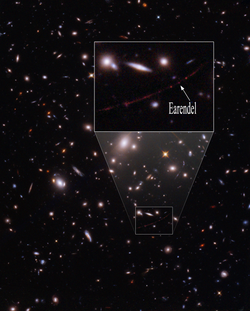WHL0137-LS
| 观测资料 历元 J2000 | |
|---|---|
| 星座 | 鲸鱼座 |
| 星官 | |
| 赤经 | 01h 37m 23.232s[1] |
| 赤纬 | –8° 27′ 52.20″[1] |
| 视星等(V) | |
| 天体测定 | |
| 距离 | z=6.2±0.1,同移距离280亿 ly |
| 特性 | |
| 视星等 (F435W) | 27.2[1] |
| 详细资料 [1] | |
| 质量 | 144 M☉ |
| 半径 | 90 R☉ |
| 亮度 | 2,050,000 L☉ |
| 温度 | 23,000 K |
| 金属量 [Fe/H] | -8.41 dex |
| 年龄 | 12.9 Gyr |
| 其他命名 | |
埃兰迪尔(Earendel)
| |
WHL0137-LS,又称“埃兰迪尔”(英语:Earendel;在古英语中意指“晨星”),是在2022年发现,迄今为止观测到的最遥远恒星[2]。
观测
[编辑]2022年3月30日,美国太空总署宣布WHL0137-LS的发现[1][3],此前哈伯太空望远镜曾分别在2016年6月7日、7月17日、2019年11月4日11月27日对其拍摄[4]。该恒星是由于正前方星系团发生重力透镜效应,放大了来自恒星的光才被发现。透镜效应的电脑模拟显示,WHL0137-LS的亮度被放大了1000至40000倍[5]。
WHL0137-LS的昵称“埃兰迪尔”来自古英语的“晨星”(Aurvandill),后者又有“冉冉升起的光”之意[1][6]。埃兰迪尔也是J·R·R·托尔金小说《精灵宝钻》中带着精灵宝钻乘船飞往天空,像“晨星”一样明亮的半精灵的名字,NASA天文学家米雪儿·塞勒证实此名称是为了致敬托尔金[7]。此外,WHL0137-LS的寄主星系则被叫作“黎明之弧”(Sunrise Arc)[8]。
哈伯太空望远镜未来将进一步观测WHL0137-LS,以确认其特性[9],而詹姆斯·韦伯太空望远镜未来亦会有同样的任务[1]。拥有更高灵敏度的韦伯太空望远镜将分析WHL0137-LS的恒星光谱,以揭示是否有比氢和氦重的元素存在[8],并确认其是否真的是一颗恒星[10][11]。
物理性质
[编辑]经过探测,WHL0137-LS的光确定是在大爆炸后9亿年发出,且有着6.2±0.1的红移,意味着这颗恒星的光需129亿年才能到达地球[1][5][12],而之前发现的最远恒星MACS J1149 Lensed Star 1(又称“伊卡洛斯”)[13]的红移只有1.49。然而由于宇宙膨胀,WHL0137-LS的观测位置现在距离地球有280亿光年[10]。
WHL0137-LS的质量可能介乎50到100个太阳质量之间[14],表面有效温度约为20,000 K(20,000 °C;36,000 °F)[1]。由于其巨大的质量,科学家们相信该恒星在诞生后不到几百万年便会成为超新星[14][15]。尽管几率很微,但WHL0137-LS为第三星族星可能性仍存,这也意味着它除了氢和氦这两种太初元素以外,几乎不包含其他元素[2]。
参见
[编辑]参考资料
[编辑]- ^ 1.0 1.1 1.2 1.3 1.4 1.5 1.6 1.7 1.8 Welch, Brian; Coe, Dan; Diego, Jose M.; Zitrin, Adi; Zackrisson, Erik; Dimauro, Paola; Jiménez-Teja, Yolanda; Kelly, Patrick; Mahler, Guillaume. A highly magnified star at redshift 6.2. Nature. 2022-03, 603 (7903): 815–818 [2022-04-02]. ISSN 1476-4687. PMID 35354998. doi:10.1038/s41586-022-04449-y. (原始内容存档于2022-03-30) (英语).
- ^ 2.0 2.1 Gianopoulos, Andrea. Record Broken: Hubble Spots Farthest Star Ever Seen. NASA. 2022-03-29 [2022-04-05]. (原始内容存档于2022-03-30).
- ^ Record Broken: Hubble Spots Farthest Star Ever Seen. HubbleSite.org. [2022-04-05]. (原始内容存档于2022-03-30) (英语).
- ^ Lensed Star Earendel. HubbleSite.org. 2022-03-30 [2022-04-02]. (原始内容存档于2022-04-02).
- ^ 5.0 5.1 Timmer, John. Hubble picks up the most distant star yet observed. Ars Technica. 2022-03-30 [2022-04-05]. (原始内容存档于2022-03-30) (美国英语).
- ^ Wednesday, Jake Parks | Published:. Hubble spots the farthest star ever seen. Astronomy.com. [2022-04-05]. (原始内容存档于2022-03-31) (英语).
- ^ Meet Earendel: Hubble telescope's most distant star discovery gets a Tolkien-inspired name. Space.com. 2022-03-31 [2022-04-05]. (原始内容存档于2022-03-31) (英语).
- ^ 8.0 8.1 Rauchhaupt, Ulf von. Tiefe Astronomie: Der früheste Stern. FAZ.NET. [2022-04-05]. ISSN 0174-4909. (原始内容存档于2022-03-31) (德语).
- ^ Coe, Dan; Welch, Brian; Acebron, Ana; Avila, Roberto; Bradac, Marusa; Bradley, Larry; Diego, Jose M.; Dimauro, Paola; Farag, Ebraheem. Monitoring Earendel, the Lensed z 6 Star. HST Proposal. 2021-06-01: 16668 [2022-04-05]. (原始内容存档于2022-04-01).
- ^ 10.0 10.1 Kabir, Radifah. Hubble Detects Earendel, The Farthest Star Ever Seen. It’s 28 Billion Light Years Away. news.abplive.com. ABP News. 2022-03-31 [2022-03-31]. (原始内容存档于2022-03-31) (英语).
- ^ Starr, Michelle. The Most Distant Single Star Was Just Detected, as Ancient as The Cosmic Dawn. ScienceAlert. [2022-04-05]. (原始内容存档于2022-03-31) (英国英语).
- ^ Letzter, Rafi. Meet Earendel, the most distant star ever detected. The Verge. 2022-03-30 [2022-04-05]. (原始内容存档于2022-03-30) (英语).
- ^ Kelly, Patrick L.; Diego, Jose M.; Rodney, Steven; Kaiser, Nick; Broadhurst, Tom; Zitrin, Adi; Treu, Tommaso; Pérez-González, Pablo G.; Morishita, Takahiro. Extreme magnification of an individual star at redshift 1.5 by a galaxy-cluster lens. Nature Astronomy. 2018-04, 2 (4): 334–342. ISSN 2397-3366. doi:10.1038/s41550-018-0430-3. (原始内容存档于2018-05-04) (英语).
- ^ 14.0 14.1 Gravitationslinsen: Entferntester Stern dank 1000-facher Vergrößerung entdeckt. www.spektrum.de. [2022-04-05]. (原始内容存档于2022-03-31) (德语).
- ^ This is Earendel, the most distant star ever seen by humans. Los Angeles Times. 2022-03-30 [2022-04-05]. (原始内容存档于2022-03-30) (美国英语).




